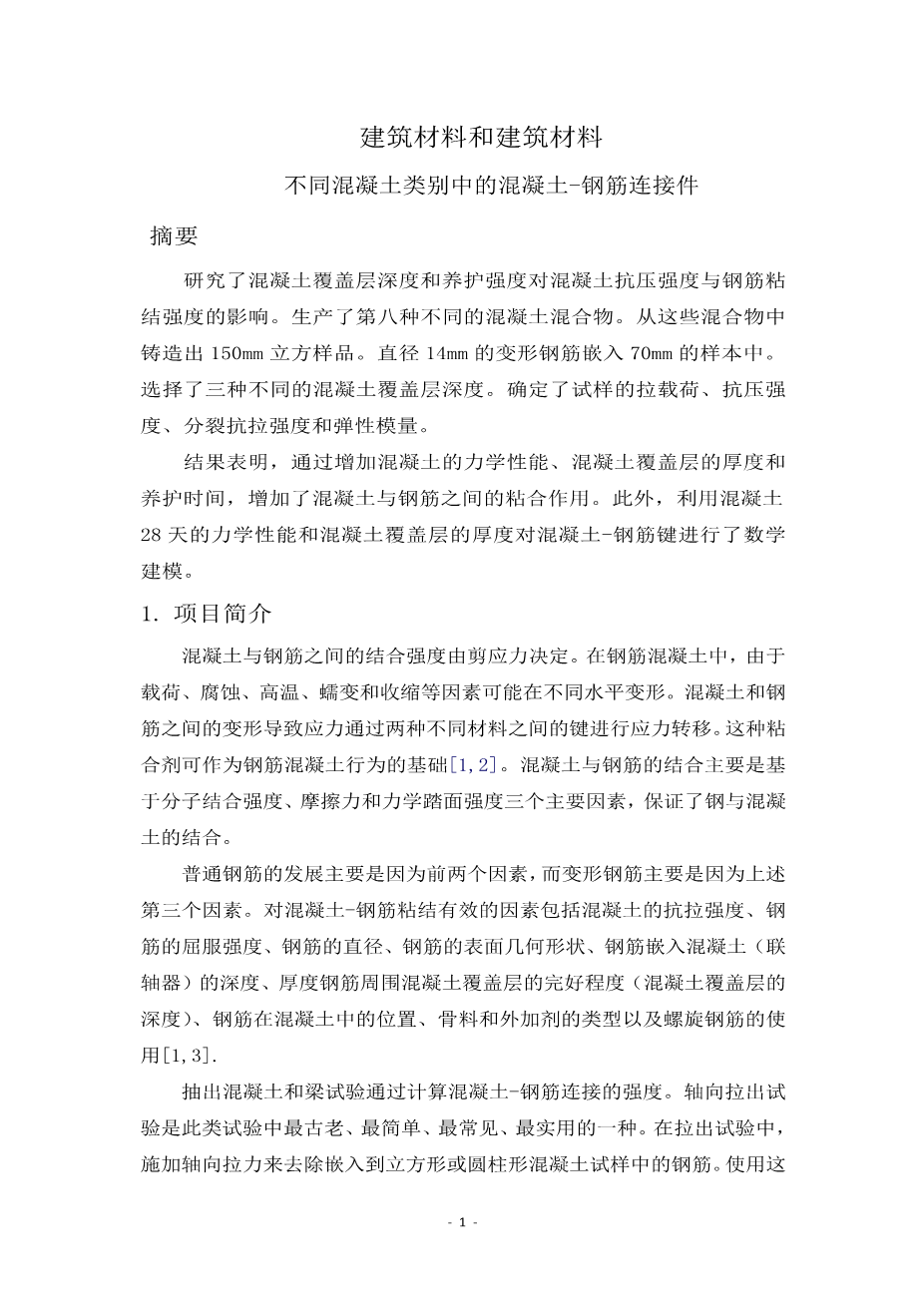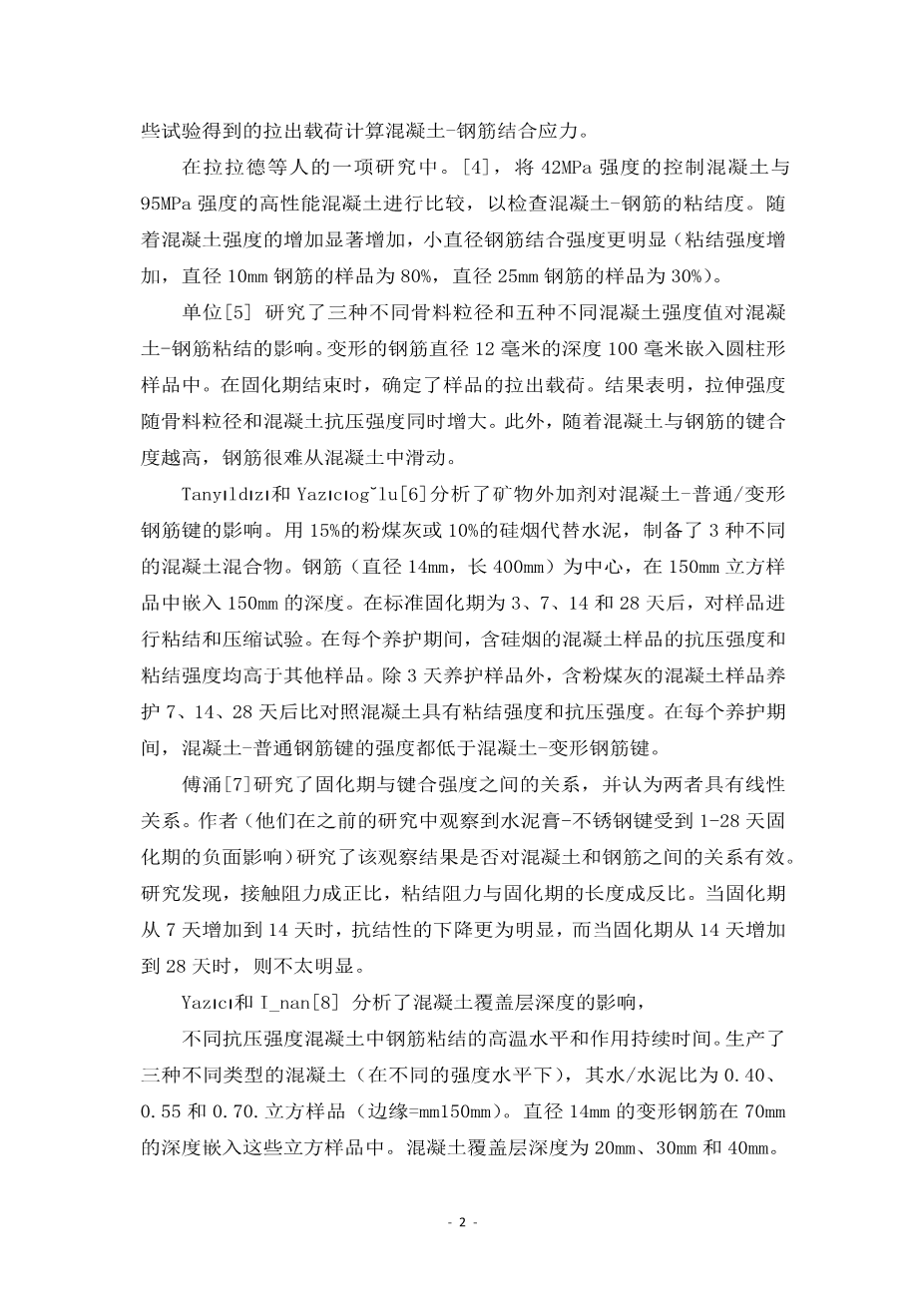Construction and Building Materials
Concrete–reinforcement bond in different concrete classes
a b s t r a c t
In this study, the effect of the depth of concrete cover and the curing time on the concretereinforcement bond strength in concretes with eighth different compressive strength levels was investigated. Eighth different concrete mixtures were produced. 150 mm cubic specimens were cast from these mixtures. Deformed reinforcements of 14 mm diameter were embedded at a depth of 70 mm into specimens. Three different depth of the concrete cover were selected. The pull out loads, compressive strength, splitting tensile strength and modulus of elasticity of the specimens were determined.
It was found that, the bonding between concrete and steel reinforcement was increased by increasing the mechanical properties of the concrete, the thickness of concrete cover and curing time. In addition, the concretereinforcement bond was mathematically modeled using 28-day mechanical properties of the concrete and the thickness of concrete cover.
1.Introduction
The strength of the bond between concrete and steel reinforcement is determined by shear stress. In reinforced concrete, concrete and steel reinforcement may deform at different levels due to such factors as load, corrosion, high temperature, creep and shrinkage. Such deformations between the concrete and reinforcement result in the transfer of stress via the bond developed between the two different materials. This bond serves as the basis for the behavior of the reinforced concrete [1,2]. The concretereinforcement bond is believed to be founded on three main factors: molecular bond strengths, friction force and mechanical tread strength, which ensure the bond between steel and concrete.
The bond is known to develop in plain reinforcement bars mainly due to the first two factors and in deformed reinforcement bars mainly due to the third factor listed above. Factors effective on the concretereinforcement bond include the tensile strength of concrete, yield strength of the steel, diameter of the reinforcement, surface geometry of the reinforcement, the depth at which the reinforcement is embedded into the concrete (coupling), the thickness of the concrete cover surrounding the reinforcement (depth of concrete cover), position of the reinforcement in the concrete, the types of aggregates and admixtures used, and the use of spiral rein forcement [1,3].
The strength of the concretereinforcement bond is calculated viapull out and beam tests. The axial pull out test is the oldest, simplest, most common and most practical of such tests. In pull out tests, an axial pulling force is applied to remove the reinforcement embedded into the cubic or cylindrical concrete specimen. Concretereinforcement bond stress is calculated using the pull out load obtained from these tests.
In a study by Larrard etal. [4], control concrete with 42 MPa strength was compared to a highperformance concrete with 95 MPa strength in order to examine the concretereinforcement bond. The bond strength was found to increase significantly with an increase in concrete strength and the increase in bond strength was more evident in the smalldiameter reinforcements (the increase in bond strength was calculated as 80% in samples with 10 mm diameter reinforcements and 30% in samples with 25 mm diameter reinforcements).
Uuml;nal [5] examined the effects of three different aggregate grain diameters and five different concrete strength values on the concretesteel reinforcement bond. Deformed steel reinforcementsof 12mm diameter were embedded at a depth of 100 mm into cylindrical specimens. At the end of the curing period, the pull out loads of the specimens was determined. The results showed that the pull out strength increased in parallel with the aggregate grain diameter and concrete compressive strength. In addition, as the concretereinforcement bond gets higher, it becomes more difficult for the steel reinforcement to slip from the concrete.
Tanyıldızı and Yazıcıog˘lu [6] analyzed the effect of mineral admixtures on concreteplain/deformed reinforcement bonds. Three different concrete mixtures were prepared by replacing cement with 15% fly ash or 10% silica fume. Reinforcements (14 mm in diameter and 400 mm in length) were centered and embedded at a depth of 150 mm in 150mm cubic specimens. After standard curing periods of 3, 7, 14 and 28 days, the specimens were subjected to bond and compression tests. The compressive strength and bond strength of the concrete specimens containing silica fume were found to be higher for each curing period than the other specimens. Except for 3-day cured samples, the concrete specimens containing fly ash were found to have higher bond strength and compressive strength than the control concrete after 7, 14 and 28 days of curing. The strength of the concreteplain reinforcement bond was found to be lower at each curing period than the concretedeformed reinforcement bond.
Fu and Chung [7] examined the relationship between curing period and bond strength, which are believed to have a linear rela- tionship. The authors (who had observed in a previous study that the cement pastestainless steel bond was negatively affected by a curing period of 1–28 days) investigated whether this observation was also valid for the relationship between the concrete and reinforcement. It was found that contact resistance was in direct proportion and bond resistance was in inverse proportion to the length of the curing period. The decrease in bond resistance was found to be more evident when the curing period was increased from 7 to 14 days and less evident when the curing period
剩余内容已隐藏,支付完成后下载完整资料


英语译文共 8 页,剩余内容已隐藏,支付完成后下载完整资料
资料编号:[605629],资料为PDF文档或Word文档,PDF文档可免费转换为Word
课题毕业论文、外文翻译、任务书、文献综述、开题报告、程序设计、图纸设计等资料可联系客服协助查找。


